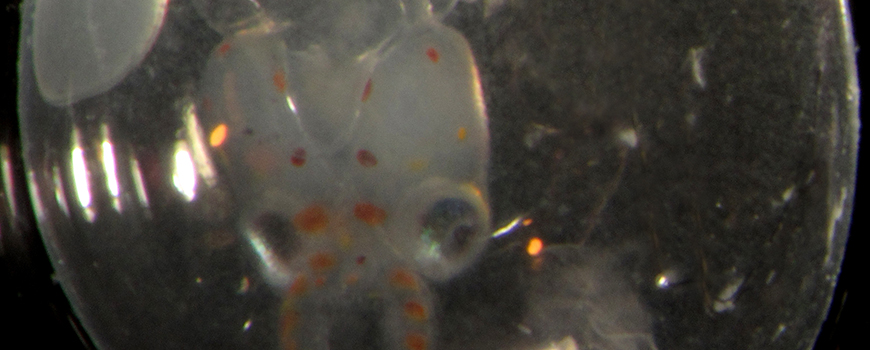Global S&T Development Trend Analysis Platform of Resources and Environment
| Research Highlight: A Story of Survival | |
| admin | |
| 2017-01-19 | |
| 发布年 | 2017 |
| 语种 | 英语 |
| 国家 | 美国 |
| 领域 | 资源环境 |
| 正文(英文) |  Researchers raised squid embryos like this one in conditions that simulate possible oceans of the future Except for their eyeballs and polka dots, market squid larvae are mostly transparent. The tiny eggs shimmer vulnerably on the ocean floor for weeks while they develop. But a new study suggests that despite their apparent daintiness, squid babies are a rugged example of survivors in tough times. A recent study by current and former Scripps Institution of Oceanography at the University of California San Diego researchers shows that squid embryos are resilient to the corrosive and poorly oxygenated water that might become more common in future oceans. The size squid attain when they hatch is critical to their survival, said Scripps Oceanography alumnus Mike Navarro, the lead author of the study. Embyros that developed in corrosive and oxygen depleted waters were virtually the same size as those exposed to non-corrosive, oxygen-rich seawater. “After hatching, the squid embryos need to capture prey within the first day or two or they die,” said Navarro. Market squid are a wild-caught California seafood and one of the state fishing industry’s most important catches. Relative to other West Coast fish species, the rapidly reproducing squid are among the most sustainable regional fisheries. However, along much of the West Coast, climate change presents a two-pronged blow to the marine ecosystems the squid inhabit. Ocean acidification is the decrease of pH caused as surface waters absorb increasing amounts of carbon dioxide from the atmosphere. Deoxygenation is the spread of low oxygen areas in the ocean, especially into shallow waters. Both have emerged in recent years as critical issues in ocean research. Balanced ocean chemistry is needed in order for many animals to build shells, for example. As climate change continues, changes in both the levels of oxygen and pH will alter marine ecosystems and the life, including humans, that depends on them. The study was part of Navarro’s dissertation while a student at Scripps. He received his doctorate from Scripps in 2014 and is now an assistant professor of marine fisheries at the University of Alaska Southeast. In the study, he and other researchers watched squid embryos develop under different levels of pH and oxygen in laboratory test tanks. They set pH levels in some tanks based on predictions of ocean acidification in the waters off La Jolla, Calif. near the Scripps campus. They found that development of embryos was negatively affected by waters that had low oxygen levels but normal pH levels. They also found that development of embryos was also negatively affected by waters with lowered pH levels but normal oxygen levels. When the two factors were combined, however, as they would be in the wild, the negative effects were diminished. Garfield Kwan, coauthor and PhD student at Scripps, said he was “surprised by how well the squid copes with the stressors together, and how poorly they deal with the stressors when they were decoupled.” “These babies are tough!” said Navarro of the squid embryos. “This is probably good news for the ecology and fishery because if squid respond similarly in nature, then the squid babies will likely hatch even if they are exposed to corrosive and oxygen-depleted waters for long durations.” The squid did not make it to maturity entirely unscathed. The experience of acidic, low oxygen waters slowed development. Typical squid embryo development takes approximately a month. However, it took the larvae up to a week longer to hatch than the squid raised in present-day conditions. Scripps biological oceanographer Lisa Levin, a principal investigator on the project, said more work needs to be done to understand the response of individual species and entire ecosystems to stressors acting alone and in concert with each other. That includes observing the coping mechanisms of organisms that are in places already experiencing the kinds of conditions the team simulated in the lab. “We now live with a multi-stressed ocean,” said Levin. “You can find places on the planet that already look like future scenarios.” The study was published Dec. 9, 2016 in the journal PLoS ONE. NOAA, California Sea Grant, the Department of Commerce, and the National Science Foundation funded the work. Kate Furby is a sixth-year student in the laboratory of marine ecologist Stuart Sandin
This story appears in explorations now, Scripps Institution of Oceanography's award-winning ocean and earth science magazine. Sign up to receive our free monthly story roundup.
|
| URL | 查看原文 |
| 来源平台 | Scripps Institution of Oceanography |
| 文献类型 | 新闻 |
| 条目标识符 | http://119.78.100.173/C666/handle/2XK7JSWQ/107655 |
| 专题 | 资源环境科学 |
| 推荐引用方式 GB/T 7714 | admin. Research Highlight: A Story of Survival. 2017. |
| 条目包含的文件 | 条目无相关文件。 | |||||
| 个性服务 |
| 推荐该条目 |
| 保存到收藏夹 |
| 查看访问统计 |
| 导出为Endnote文件 |
| 谷歌学术 |
| 谷歌学术中相似的文章 |
| [admin]的文章 |
| 百度学术 |
| 百度学术中相似的文章 |
| [admin]的文章 |
| 必应学术 |
| 必应学术中相似的文章 |
| [admin]的文章 |
| 相关权益政策 |
| 暂无数据 |
| 收藏/分享 |
除非特别说明,本系统中所有内容都受版权保护,并保留所有权利。
修改评论